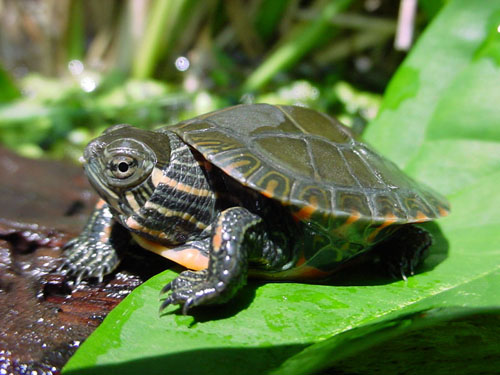
Caring for Baby Painted Turtles: A Comprehensive Guide
Painted turtles (Chrysemys picta) are small, semi-aquatic turtles native to North America. They are popular pets due to their vibrant colors and relatively easy care requirements. However, baby painted turtles require specialized care to ensure their health and well-being. This comprehensive guide will provide you with all the essential information you need to care for your baby painted turtle properly.
Enclosure
Baby painted turtles require a spacious enclosure that provides both aquatic and terrestrial areas. A 10-gallon tank is suitable for a single baby turtle, while a larger tank will be necessary for multiple turtles. The tank should be filled with water to a depth of 2-3 inches, and a basking area should be provided above the waterline. The basking area should be heated to 85-90°F (29-32°C) using a heat lamp or a submersible heater.
Substrate
The substrate in the turtle’s enclosure should be a soft, non-abrasive material that will not injure the turtle’s shell or feet. Gravel, sand, or reptile carpet are all suitable options. Avoid using materials that can trap moisture, such as wood chips or newspaper.
Water
Baby painted turtles require clean, chlorine-free water. The water should be changed regularly, and a filter should be used to remove waste and debris. The water temperature should be maintained between 75-80°F (24-27°C).
Lighting
Baby painted turtles require both UVA and UVB lighting to stay healthy. UVA lighting helps regulate the turtle’s circadian rhythm and appetite, while UVB lighting is essential for calcium absorption and bone development. A combination of a fluorescent bulb and a heat lamp can provide the necessary lighting.
Diet
Baby painted turtles are omnivorous and will eat a variety of foods. A balanced diet should include:
- Protein: Live insects, such as crickets, mealworms, and waxworms
- Vegetables: Leafy greens, such as romaine lettuce, dandelion greens, and collard greens
- Fruits: Berries, such as strawberries, blueberries, and raspberries
- Commercial turtle food: Pellets or sticks specifically formulated for baby turtles
Feed your baby turtle once or twice a day, depending on its size and appetite.
Supplements
Baby painted turtles may require additional calcium and vitamin D3 supplements to ensure proper growth and development. These supplements can be added to the turtle’s food or water.
Handling
Baby painted turtles are delicate creatures and should be handled with care. Always support the turtle’s body and shell when handling it. Avoid picking up the turtle by its tail, as this can cause injury.
Health
Baby painted turtles are susceptible to a variety of health problems, including:
- Respiratory infections: Symptoms include sneezing, wheezing, and difficulty breathing.
- Shell rot: A bacterial infection that causes the turtle’s shell to become soft and discolored.
- Metabolic bone disease: A condition caused by a deficiency of calcium and vitamin D3. Symptoms include soft or deformed bones.
- Parasites: Internal or external parasites can cause a variety of health problems.
If you suspect that your baby painted turtle is sick, take it to a veterinarian immediately.
Conclusion
Caring for a baby painted turtle requires patience, dedication, and a commitment to providing the proper environment and care. By following the guidelines outlined in this guide, you can help your baby turtle thrive and live a long, healthy life.
